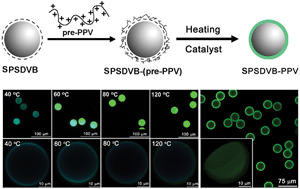Li-Juan Fan*a(范丽娟)
a Suzhou Key Laboratory of Macromolecular Design and Precision Synthesis, Jiangsu Key Laboratory of Advanced Functional Polymer Design and Application, Department of Polymer Science and Engineering, College of Chemistry, Chemical Engineering and Materials Science, Soochow University, Suzhou 215123, P. R. China
Polym. Chem. 2015, 6, 1576-1583
Poly(p-phenylenevinylene) (PPV) fluorescent microspheres were prepared in two steps. First, the positive sulfonium-salt PPV precursor (pre-PPV) was coated onto the surface of negatively charged polymer substrate spheres; second, the pre-PPV was converted into fluorescent PPV via a heterogeneous catalytic thermal elimination process. A series of fluorescent microspheres were obtained with different apparent colors and different fluorescence emissions simply by varying the elimination temperature. A spectroscopy study showed that, compared to the direct solid elimination, the spheres obtained via catalyzed elimination gave a very large variation in the emission, such as a larger shift in the wavelength, and more delicate spectra profiles with peaks and shoulders. Overlapping of the signals from blue channels and green channels in the confocal microscopy study gave a direct view of the gradual change from the blue emission to the green emission for the spheres obtained at elimination temperatures from 40 °C to 120 °C. Flow cytometry measurements showed that spheres obtained at different temperatures exhibit different combinations of the intensities from four different receiving channels. These PPV spheres were also demonstrated to have a smooth surface, monodispersity, a clear core–shell structure, thermal stability and photostability.

链接:
//pubs.rsc.org/en/content/articlelanding/2015/py/c4py01615g?iscitedby=True#!divAbstract